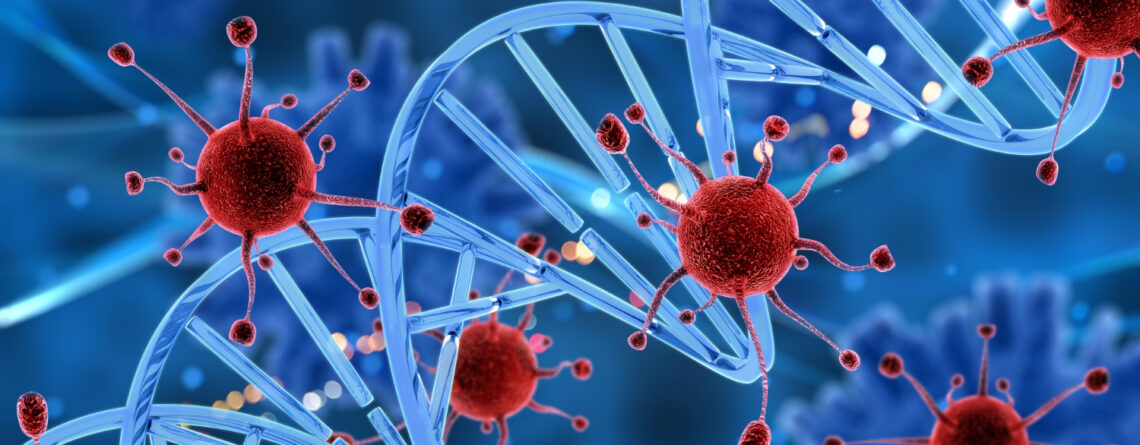The mediastinum (mediastinal space) is a complex topographical and anatomical area inside chest cavity. It is bounded by parietal leaves of pleura on sides, on the back by thoracic spine, on the bottom by diaphragm, on front by sternum, and on top it connects to cellular spaces of neck (conventional upper limit is the upper edge of sternum).
Mediastinum contains vital organs – heart, esophagus, trachea, aorta, other arterial and venous vessels, nerve trunks, lymphatic vessels and nodes, thymus gland, etc. For convenience, mediastinum is conditionally divided into front, middle and back.

Mediastinum tumors occupy a special place among remaining groups of oncological diseases, as they are united only by location. According to its structure and origin, it is a diverse group of tumor diseases, which can be primary and metastatic, benign, including mediastinal cysts, and malignant, originating from epithelial, mesenchymal, embryonic, nervous and other tissues. Mediastinum neoplasm is a rare pathology that occurs in 0.5-3% of all localizations tumors, both sexes are affected with the same frequency.
Maimonides Medical Center works under the patronage of “Keren Or for our Child” the Charitable Foundation. Therefore, all our patients who cannot pay medical bills for necessary treatment and diagnostics can count on support and help.
Mediastinal tumors, both benign and malignant, are serious diseases that require active treatment tactics immediately after detection. In addition to the well-known negative consequences of malignant neoplasms, mediastinal tumors can carry another danger – when they reach significant sizes, they can squeeze and disrupt vital organs function located in mediastinal space. Therefore, such neoplasms should be detected in early stages and complex treatment should be started quickly.
Oncology Department of Maimonides Multidisciplinary Medical Center is staffed by highly qualified doctors who have experience in managing patients with the most complex types of mediastinal tumors . So if you have been diagnosed with such a desease and do not know where to start your journey to fight it, feel free to contact a specialists of our clinic. Oncologists will propose a plan for clarifying diagnostics and create an individual scheme of complex treatment taking into account the most modern clinical recommendations and therapy protocols.
Maimonides Medical Center operates in close and fruitful cooperation with the best Israeli oncology centers . As an example of medical services provision by our institution, we chose Israeli medicine model, as one of the most effective in the world. Each individual clinical case is jointly managed by attending oncologist, the head of the department – Dr. Iryna Stefanska and responsible oncologist directly from Israel. Thanks to such coordinated work of a professional team, it is possible to achieve success in mediastinal tumors treatment of the most complex cases.
One of treatment advantages in our clinic is an individual approach to treatment . Doctors do not use a template scheme of examination and treatment for all patients with similar diagnoses, because all people and diseases are different. Planning a diagnosis and therapy scheme, all the smallest details must be taken into account – age, patient’s gender, main diagnosis, type of tumor, its characteristics, the stage of disease, general state of person’s health, severe concomitant pathologies presence, as well as patient’s wishes. At the same time, all medical and diagnostic procedures comply with thelatest clinical guidelines and standards of medical care in oncology . So there can be no doubt about the quality of received medical services.
Considering heterogeneity of mediastinal tumors, our Oncology Department employs all narrow specialists whose help a patient with mediastinal space tumor may need. A whole multidisciplinary team is involved in treatment and diagnostic process – oncologists, general surgeons, cardiac surgeons, thoracic surgeons, radiation therapists, chemotherapists, radiologists, endoscopists, rehabilitators, neurologists, neurosurgeons, psychologists and other narrow specialists who may be needed in such a patient treatment. Thus, a person can receive the entire range of necessary medical services within the walls of one institution, starting with diagnosis, ending with complex treatment and rehabilitation after it. Such a patient-oriented approach greatly facilitates a way for patient and treatment compliance for specialist.
Our department is equipped only with modern medical and diagnostic equipment of an expert class. If a certain narrow specialist or rare medical and diagnostic equipment is not available, patient is referred to subsidiary institutions of Maimonides Medical Center or our Israeli partner clinics, where he is guaranteed to receive the full range of necessary medical services.

Types of mediastinum tumors
Depending on the origin (source of growth), mediastinum neoplasms are divided into:
- Primary – grow directly from organs located in mediastinal space (thymus, heart, esophagus, trachea, etc.) or anatomical structures limiting mediastinum (sternum, diaphragm, pleura).
- Secondary – metastatic lesions of organs and walls of mediastinum in case of another location primary malignant tumors.
The most common types of primary neoplasms of the mediastinal space:
- Benign and malignant tumors of thymus gland (thymus).
- Tumors of neurogenic origin – schwannoma, neurofibroma, neurogenic sarcoma, ganglioneuroma.
- Hodgkin's and non-Hodgkin's lymphomas.
- Tumors from tissues displaced into mediastinal space – thyroid cancer, intrathoracic goiter, germinogenic (embryonic) tumors (seminoma, teratoma, teratoblastoma, chorioepithelioma), soft tissue tumors (lipoma, liposarcoma, fibroma, fibrosarcoma, angioma, angiolipoma , angiosarcoma, etc.), heart tumors (they are often separated into a different groups, not classified as mediastinal neoplasms), true mediastinal cysts (pericardium, thymus, bronchogenic cysts).
Thymomas (thymus gland tumors) are in first place among mediastinal tumors in terms of detection frequency – 40%, followed by neurogenic neoplasms – 20% lymphomas – 13%, germinogenic tumors – 12%, mediastinal cysts – 10% and the rest of neoplasms.
Mediastinal tumors symptoms
Many volumetric mediastinum neoplasms have an asymptomatic course . Symptoms appear earlier if tumor is malignant. Most often, disease is manifested by chest pain and weight loss. Lymphomas are characterized by fever and unmotivated weight loss.
Volumetric mediastinum neoplasms can cause trachea and bronchi compression, stridor (whistling, noisy breathing), recurrent bronchitis or frequent pneumonia.
First of all complaints and manifestations, depend on neoplasm localization. Large anterior mediastinum tumors lead to breath shortness in supine position. Middle mediastinum noeplasms can compress blood vessels or respiratory tract, leading to superior vena cava syndrome development or respiratory tract obstruction. Posterior mediastinum tumors can grow into esophagus, which leads to dysphagia or odynophagia development (disordered swallowing, pain when swallowing).

Mediastinal tumors diagnostic methods
The earlier mediastinal tumor diagnosis is made, the better the prognosis and treatment outcome. Therefore, high-quality and quick diagnosis is an extremely important stage. Maimonides Clinic uses only modern, expert-class equipment, all our doctors are perfectly mastered all necessary examining methods an oncological patient, and are able to correctly interpret received data, which helps them to create a modern, individual and effective treatment plan.
Volumetric mediastinum tumors, as a rule, are detected accidentally during chest x-rays (XR) or other radiological methods of X-ray research. To determine causative factor, additional diagnostic examinations, usually imaging methods and biopsy, are indicated.
The most informative diagnostic method is computed tomography with contrast. Thoracic organs CT scan allows differentiating between normal variants and benign formations (fatty, liquid cysts) with other processes (primarily, malignant). Magnetic resonance imaging (MRI) is performed if the observed structure is cystic. MRI can be useful in determining whether a tumor mass compresses or penetrates adjacent anatomical structures.
As a rule, a fine-needle aspiration biopsy allows to diagnose the type of malignant neoplasms. A fine-needle aspiration biopsy is usually sufficient to confirm carcinomatous masses, but trepan biopsy should be performed if lymphoma, thymoma, or neurogenic tumor is suspected.
After biopsy we send all histological materials to the world's best pathohistological laboratories (Israel, Germany, USA).). Thanks to such double molecular checks, we are absolutely sure of diagnosis correctness and effectiveness of chosen treatment regimen.
Our patients also have access to biopsy specimens innovative molecular diagnostics (molecular genetic studies). This is a mandatory part of modern oncological diseases diagnosis. Thanks to molecular genetic diagnostics, we can choose the most effective treatment regimens, because the response to certain drugs effect depends on the type of changes. An example of such modern diagnostics are test systems for molecular genetic testing. Such as the Foundation One and Caris Molecular Testing.
Another very effective and modern examination method is mediastinoscopy. Mediastinum is examined using an endoscopic technique – a mediastinoscope. This is a specialized instrument with a camera that is inserted into mediastinal cavity. For this, specialists make small incisions on the neck. Mediastinoscope application allows doctor to study mediastinal organs condition carefully, to conduct a biopsy of suspicious tissue or a lymph node.
Innovative methods such as PET-CT, PET-MRI , and bone scintigraphy are used for a complete body scan and possible distant metastases detection. These examinations help to establish the stage of malignant process correctly and to choose an effective treatment for each stage and each patient. All necessary diagnostic procedures can be performed directly in clinic, without leaving Ukraine.
Also, an important stage is the level of specific tumor markers determination in the blood. For example, alpha-fetoprotein and β-chorionic gonadotropin of a person, which are increased in germinogenic tumors. Determination of these substances is used not only for diagnosis purpose, but also for differential diagnosis conducting, monitoring the course of disease and prognosis determining.

Mediastinal tumors modern treatment
One of the most important mediastinal tumors treatment advantages in our clinic is a comprehensive approach application to therapy . In the fight against a malignant tumor, an oncologist uses the entire available arsenal of treatment methods. Therapy is always combined with several methods. Typically, treatment regimen includes tumor surgical removal in combination with chemotherapy and/or radiation therapy. In some cases, innovative treatment methods are added to the treatment program (targeted drugs, immunobiological drugs, etc.).
Treatment depends entirely on process etiology. Some benign tumors, in particular pericardial cysts, are observed. Most malignant tumors are removed, but in lymphomas it is more appropriate to use chemotherapy.
Since mediastinum is limited by chest cavity, any open surgical intervention is very traumatic. Therefore, we mainly perform minimally invasive removal of mediastinal tumors using endoscopic techniques. Of course, such interventions may not be suitable for every patient, and some still require open surgery. Our surgeons master all operative techniques of mediastinal organs necessary interventions. Robotic methods of thoracoscopic surgery are also available to our patients.
In order to consolidate obtained result, surgery is supplemented with chemotherapy, radiation or drug treatment, depending on diagnosis.
At Maimonides Oncology Department, chemotherapy is also used in complex treatment for cancer desease. Our patients are prescribed only chemotherapy drugs of the latest generation, which have a minimum number of unwanted reactions from healthy organs and tissues. Doctors select chemotherapy drugs for each patient individually, based on results of modern molecular genetic tests. This approach allows us to find the most effective means for a specific tumor, to calculate required number of chemotherapy courses and their duration accurately.
Radiation therapy can be used before or after surgery for mediastinal malignancies. As a rule, they use remote radiation with modern devices – linear accelerators. With the help of innovative technologies, it is possible to provide targeted tumor radiation, minimizing the dose for remaining healthy tissues and organs of mediastinum. Modern linear accelerators available to our patients allow us to perform intensity modulated radiation therapy (IMRT), rotational (moving radiation) with beam intensity modulation (VMAT), as well as stereotaxic radiation therapy (SRT) and stereotaxic radiosurgery (SRS). Such equipment allows us to effectively fight cancer diseases that were previously considered incurable.
